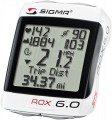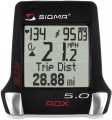The number of lines on the screen of the bike computer.
In this case, only lines intended for displaying basic data are meant — values of speed, time, etc.; strings for service characters are not taken into account. Thus, the number of lines is the number of parameters that can be simultaneously displayed on the bike computer display: for example, on a two-line screen, you can see the current speed and ride time. And in some models, there may be two parameters per line. The lines themselves in most bike computers are two, less often —
three or
four, it makes no sense to use more.
—
GPS module. The built-in GPS satellite navigation module is responsible for determining the current geographic coordinates of the device. How this data is used can vary. With some models, using GPS, the accuracy of speed and/or distance measurements is increased, others are able to record tracks of the routes traveled, which can be viewed on an external device or even on the bike computer itself. GPS data can also use an
altimeter. And in the most advanced models, even full-fledged navigation with built-in maps is supported.
—
Bluetooth. A wireless communication technology used to connect directly between different devices. The most popular application for such a connection is to connect a wireless sensor (see "Type"); in this case, one of the advantages of Bluetooth is its excellent noise immunity and the almost zero chance of overlapping different signals one on another, even with an abundance of wireless devices nearby. In addition, Bluetooth can be used to connect to a smartphone / PC (see "Functions"), as well as for more specific purposes, such as connecting a wireless headset and receiving voice prompts from a GPS navigator.
—
Thermometer. Sensor for determining the ambient temperature. It can be useful both for assessing the current situation (for example, if a cyclist gets into the saddle hot after a warm-up
...and is not sure about his perception of temperature), and, in some cases, for predicting the weather.
— Altimeter. Sensor to determine the current altitude above sea level. Altitude can be determined by two main methods: barometer and GPS (see relevant paragraphs). In the first case, the pressure difference between the reference and current altitude is determined; in the second, a database is used about the height of the terrain with certain coordinates. The height designation format can also be defined: in some models it is indicated relative to sea level, in others it is relative to a conditional zero point specified by the user. Anyway, the information from the altimeter can be useful for assessing the elevation changes during the trip.
— Heart rate monitor. Ability to determine the current heart rate. The pulse is one of the most important parameters for more or less serious training; for different purposes (weight loss, keeping fit, gaining muscle mass), it is required to maintain different heart rates during exercise (its specific value can be determined using special methods). The heart rate monitor sensor is usually made remote and fixed on the body — this is due to the peculiarities of this type of measurement. Note that the mention of a heart rate monitor does not necessarily mean the presence of such a sensor in the kit — it may need to be purchased separately. Also note that the bike computer itself can support advanced heart rate monitor functions: maximum heart rate, average heart rate, signals about work in the optimal range, etc.
— Barometer. Sensor for determining the current atmospheric pressure. This information may be used for various purposes. So, in some models, the operation of the altimeter (see the relevant paragraph) is based on data from the barometer. And changes in atmospheric pressure can be a sign of certain changes in the weather — for example, a sharp "fall" in the barometer usually indicates the approach of rain.
— ANT+ support. Bike computer support for ANT+ data transfer technology. This technology has been specially developed for use with sports devices, including compact ones. It features good connection reliability and economical power consumption. In cycling computers, ANT+ can be used both to connect sensors and to connect the computer itself to a smartphone or other gadget that supports this technology. At the same time, ANT + devices are compatible with each other in terms of basic capabilities regardless of the manufacturer, which allows, for example, to supplement the bike computer with “non-native” wireless sensors if the standard ones are out of order.
